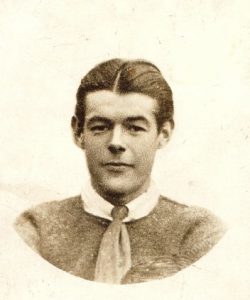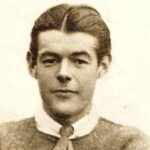
Hull Pals Memorial Post 12/08/2014. L/CPL JAMES TODD, 11/305. Born in Hull, 1893. James was the eldest of five sons to John and Sarah Todd of 36 Strickland Street, Hessle Road, Hull. A Barman by trade, he enlisted at Hull City Hall, on Monday 7th September 1914, joining the fledgling 11th Battalion East Yorkshire Regiment, ‘The Tradesmen’, 2nd Hull Pals.
Having served in Egypt over the winter of 1915-16, he arrived in France in the March and served on the Somme, where he was wounded on 13th November 1916. (While being treated at Puchervillers hospital, he gave his new Testament, to a Welsh soldier, Private, David Jones, whom he befriended. Found in a Charity shop in Colwyn Bay, the book was reunited with the Todd family in 2006).
James was shipped back home to recuperate. His wounds must have been serious as he did not return to the trenches until 2nd June 1917, meaning he missed the bloodbath at Oppy Wood.
James was fatally wounded in the defence of Ayette, during the German Spring Offensive. He died the following day, on 28th March 1918, aged 24.
He is buried at Doullens Communal Cemetery Extension No.1, Somme, France. He was 24 years old. Two of James’s brothers also served, though both appear to have thankfully survived.
I am grateful to Dr. Marianne M Gilchrist for the following photo of James Todd and other family information. https://webmail.karoo.co.uk/mime.php?
This is another maternal great-uncle of mine: his full name was James Henry Melton Todd (although his birth certificate says Todd Melton, and inaccurately names his mother’s legal husband as his father). His father’s name was John Thomas Todd, his mother Mrs Sarah Jane Melton, nee Nichols. She was a bigamist, who married Jack Todd, her long-term partner, in 1905, when falsely claiming to be a widow* (she had left a husband and son in Scarborough c. 1891 and come to Hull for fish gutting work). I have photographs of James, who was my grandfather’s eldest full brother, and of Walter. His brother John was generally known in the family as George (he was John George Melton Todd) to differentiate him from his father, who was known as ‘Jack’.
*My great-grandmother’s legal husband actually outlived my great-grandfather.
Re: the Melton Todds at 14 Frederick’s Terrace:
They were (in descending age order after James Henry):
John George Melton Todd (1895-1966) – Royal Field Artillery
Henry Melton Todd (1897-1985) (not sure about his service record; had
poor eyesight.)
Walter Melton Todd (1898-1924) RAMC (despite being partially sighted, like Harry)
Arthur Melton Todd (1900-66) (merchant seaman in both World Wars, then
in Home Guard in latter part of WW2)
Thomas Bravender Melton Todd (1902-41, civilian casualty of Hull Blitz)
Stanley (a baby, b. & d. 1904.)
One of my second-cousins has James Henry Melton Todd’s medals, and a memorial plaque honouring Tom Miskin.
I don’t know what the war record was of their half-brother, Ernest Bravender Melton (1888-1956): I only discovered his existence a couple of years ago. He ended up as an electrician in London. I attach a photo of James Henry Melton Todd.
Background. When the German spring offensive opened on 21 March 1918, 31st Division was in reserve, with 10th and 11th EYR Battalions digging trenches in the ‘Army Line’ behind the front. On 23 March the division was sent up to hold off the German attack at St Léger, but 92 Bde remained in reserve at Ervillers, improvising the defences. Ervillers was attacked on the evening of 24 March, the defence being confused by British troops retreating from the forward defences. Two companies of 10th Bn were pushed up to reinforce 11th Bn fighting in the village streets. About midnight a German patrol got into the village, but was captured by 11th Bn’s HQ staff. The following day the 11th Bn was reinforced by 10th Bn Manchester Regiment of 42nd (East Lancashire) Division and their combined fire stopped the German advance. However, events elsewhere meant that the 31st and 42nd Divisions were ordered on the morning of 27 March to retire through Courcelles-le-Comte.
On 27th March 1917, the brigade defended Ayette aerodrome against repeated attacks from 11.20am to 16.30pm, when with both flanks ‘in the air’, the brigade pulled back to the partly-dug ‘Purple Line’ in front of Ayette village. Between 24 and 27 March, 10th EYR Bn had lost 211 officers and men, and was praised “for its exceptional gallantry on March 27” by the Commander in Chief of the BEF, Sir Douglas Haig. During the night, Lt-Col Headlam of 10th Bn led up a composite battalion of troops from the quartermasters’ details of all three battalions to take over part of the Purple Line, and they helped to recover some 18-pounder ammunition from behind enemy lines, which was fired the following day. Although fighting continued elsewhere along the line, 28 March was a quieter day for 92 Bde, and 11th Bn took over some trenches started by 210th Field Company, Royal Engineers, which they continued to dig. The brigade was relieved on 31 March and marched back to billets near Pommier.
